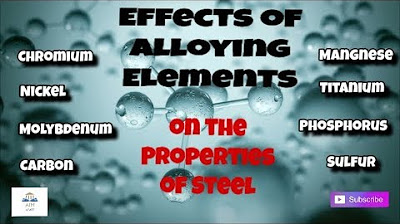Video Pembelajaran Kimia Materi Korosi pada Logam Dilengkapi dengan Animasi
Summary
TLDRThis educational video delves into the concept of corrosion, focusing on its definition and causes. It explains how metal corrosion occurs due to contact with oxygen and water vapor, forming metal oxides. The video demonstrates the corrosion process through simple experiments, showing how different conditions affect corrosion rates. It also discusses factors influencing corrosion, such as electrolyte concentration, pH levels, temperature, and moisture. Finally, it presents various prevention methods, including painting, oiling, and sacrificial anode protection, to safeguard metals from corrosion.
Takeaways
- 🚗 The purpose of painting or coloring a car is not only for aesthetics but also to prevent corrosion by avoiding direct contact with oxygen and water vapor.
- 🌀 Corrosion is defined as the formation of rust due to the oxidation of a metal, specifically when iron comes into direct contact with oxygen and water vapor, leading to rusting.
- 🔬 A simple experiment to demonstrate the corrosion process involves filling containers with water, some with added salt, and manipulating oxygen and moisture levels to observe rust formation.
- 🧪 The presence of salt in water acts as a catalyst, accelerating the corrosion process, which is evident in the experiment where the metal rusts more quickly in saltwater.
- 🌡️ Factors contributing to corrosion include the concentration of the electrolyte solution, pH level of the solution, temperature, and the moisture level where the metal is located.
- 🛠️ Applying paint is an effective method to prevent corrosion by creating a barrier against oxygen and water vapor, protecting the metal underneath.
- 💧 Applying oil or grease can reduce friction and slow down the onset of rust, as seen in the practice of oiling bike chains to prevent rusting.
- 🛡️ Other prevention methods include plastic coating, tinning, chrome plating, electroplating, and cathodic protection mechanisms.
- ⚙️ Sacrificial anode protection is a technique where a more reactive metal is used to corrode in place of the protected metal, thus preventing corrosion of the latter.
- 📚 The video script provides a comprehensive overview of the corrosion process, its causes, and various prevention techniques.
Q & A
What is the purpose of painting or coloring a car?
-The purpose of painting or coloring a car is not only to make it look attractive but also to prevent corrosion by avoiding direct contact of the metal with oxygen and water vapor.
What is corrosion?
-Corrosion is the formation of rust due to the oxidation of a metal, specifically when iron comes into direct contact with oxygen and water vapor, leading to rusting or corrosion on the iron or steel.
How can we understand the process of corrosion?
-The process of corrosion can be understood through a simple experiment where iron is exposed to water, oxygen, and other elements like salt, and observing the rust formation over time.
What happens in the experiment where an iron rod is placed in a water-filled container?
-In the experiment, an iron rod placed in a water-filled container will react with water and oxygen, leading to rust formation. If salt is added, it acts as a catalyst and accelerates the corrosion process.
Why does adding oil to the water in the experiment reduce corrosion?
-Adding oil to the water in the experiment creates a barrier that prevents oxygen from the outside from entering the water, thus reducing the conditions necessary for corrosion to occur.
What is the role of calcium chloride (CaCl2) in the vacuum experiment?
-Calcium chloride (CaCl2) is used in the vacuum experiment to absorb water vapor, thus removing moisture from the container and creating a drier environment that is less conducive to corrosion.
What are the factors that cause corrosion?
-Factors that cause corrosion include the concentration of the electrolyte solution, pH level of the solution, temperature, and the presence of water and oxygen.
How does the concentration of an electrolyte solution affect corrosion?
-The higher the concentration of an electrolyte solution, the greater the likelihood of corrosion occurring on the metal or iron.
What is the relationship between pH levels and corrosion?
-The lower the pH level or the more acidic the solution, the more susceptible the metal is to oxidation and corrosion.
What are some methods to prevent corrosion on metals or iron?
-Methods to prevent corrosion include painting, oiling, plastic coating, tinning, chrome plating, electroplating, and sacrificial anode protection.
How does sacrificial anode protection work in preventing corrosion?
-Sacrificial anode protection works by using a more reactive metal that corrodes preferentially, thus protecting the main metal structure from corrosion.
Outlines

Esta sección está disponible solo para usuarios con suscripción. Por favor, mejora tu plan para acceder a esta parte.
Mejorar ahoraMindmap

Esta sección está disponible solo para usuarios con suscripción. Por favor, mejora tu plan para acceder a esta parte.
Mejorar ahoraKeywords

Esta sección está disponible solo para usuarios con suscripción. Por favor, mejora tu plan para acceder a esta parte.
Mejorar ahoraHighlights

Esta sección está disponible solo para usuarios con suscripción. Por favor, mejora tu plan para acceder a esta parte.
Mejorar ahoraTranscripts

Esta sección está disponible solo para usuarios con suscripción. Por favor, mejora tu plan para acceder a esta parte.
Mejorar ahoraVer Más Videos Relacionados

فقه المعاملات المالية (1) - الدرس السابع عشر (1)

Metals and Non Metals | Class 10 full Chapter | Class 10 Science Chapter 3 in Animation

Literasi Ekonomi Islam

KELOMPOK SOSIAL (Pengertian, Ciri dan Faktor Pembentuk) - Materi Sosiologi Kelas 11 SMA

Effects of alloying Elements on the Properties of steel. ||Engineer's Academy||

Pengertian, Kararakteristik, Ruang Lingkup Politik
5.0 / 5 (0 votes)
